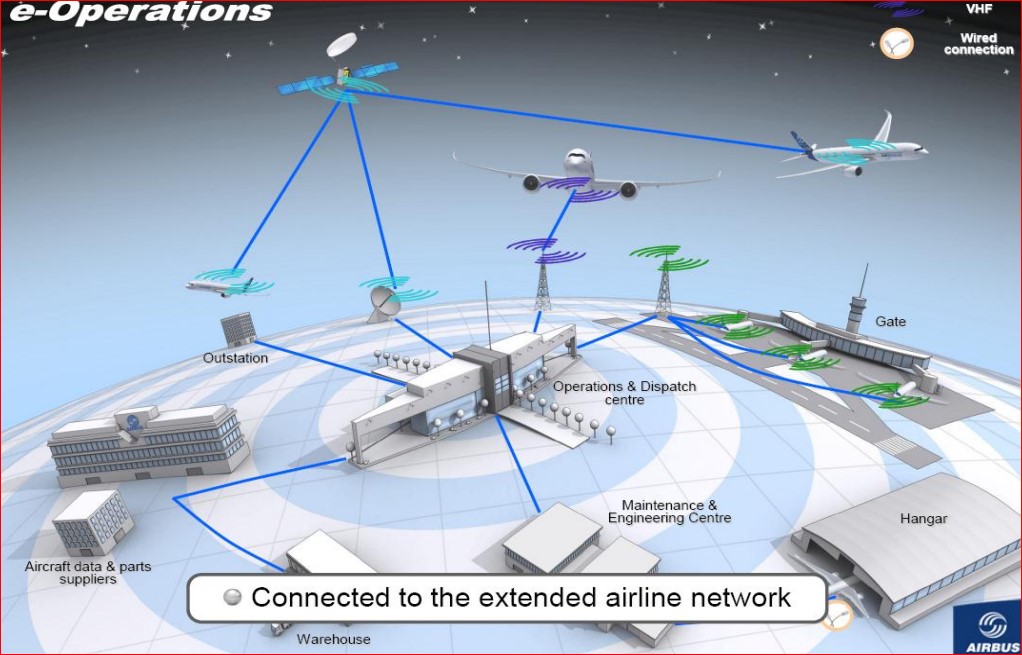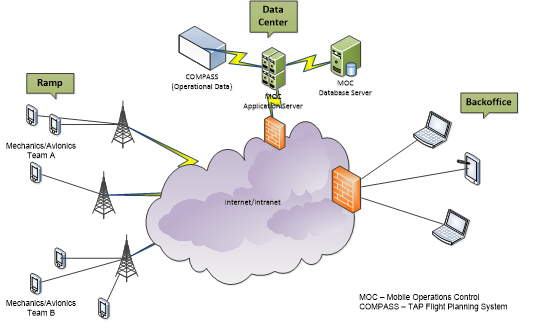Articles
| Name | Author | |
|---|---|---|
| Getting Better | View article | |
| Leveraging advantage out of software | Sander de Bree, Managing Director,ExSyn Aviation Solutions | View article |
| Mobility workforce | Fernando Ferreira Matos, Head of Information Technologies,TAP Maintenance & Engineering | View article |
| A fresh look at information | Tim Larson, Chief Product Owner for TechSight/X suite of products, InfoTrust Group | View article |
| How I see it | Michael Wm. Denis | View article |
Mobility workforce
Author: Fernando Ferreira Matos, Head of Information Technologies,TAP Maintenance & Engineering
SubscribeFernando Ferreira Matos, Head of Information Technologies at TAP Maintenance & Engineering sets out an operational strategy for Line Maintenance.
Digital Aircraft are here with the Boeing 787 and Airbus A350 aircraft – the first fully ‘next generation’ models from the two largest civil aircraft manufacturers – and, in 2016, TAP will be taking delivery of the first in its fleet of A350s.

This will mark a significant step in the airline’s fleet, in the IT needs of that fleet and the infrastructure to support it, and in our approach to IT at the heart of our business. The A350s, in particular, will be fully integrated units in the airline’s IT infrastructure and will be part of the TAP airline cloud. This means that they will always be connected to functions on which their efficient operation depends:
- Maintenance and Engineering;
- Flight Operations;
- Suppliers;
- Others as needed.

Data security and connectivity
As part of its ‘next generation’ characteristics, the A350 has a built-in on-board IT infrastructure. But, in order for that to function at its optimum there is also the need for a ground-based IT platform that can handle and exploit the significant volumes of data produced by the aircraft and can deliver the quality and quantity of data and support demanded by the aircraft if it is to realize its full business potential. Being a wholly IT enabled/digital unit, all data needed to fly and maintain the aircraft is dematerialized:
- Operational data;
- Manuals;
- Health monitoring;
- Mission data;
- Aircraft configurations.
Because of this high reliance on dematerialized data, data security and reliable connectivity are also constant requirements of these advanced aircraft. For this reason, there are concerns that in some countries, mostly in Africa, airports do not always have Wi-Fi, GSM or GPRS (general packet radio service) connections.
New concepts: e-maintenance, e-operation
With the new aircraft also come new paradigms and novel ways of looking at and delivering maintenance and operations requirements. The e-Operations concept demands a new structure of M&E, Flight Ops, IT, Data Security, etc., with new roles and responsibilities.
e-Maintenance has seen hardware replaced by software and the advent of field loadable software. We are also going to have to get used to electronic deliveries in a dematerialized ‘equipment’ supply chain where knowing that an item is where it is needed, when it is needed will be more important than simply having it in stock. And part of the new aircraft package includes ground-based tools enabling fleet configuration management to be carried out in a virtual environment, albeit that the aircraft will still be configured for a very real environment.
Aircraft health monitoring will similarly be improved with systems and engines data as well as information relating to Flight Operations Quality Assurance (FOQA) processes being generated in real time and, as importantly, being available in real time to all departments that need to record or act on that data or information. Also, other elements of flight operations technical data will be integrated into the wider airline system through such developments as EFBs with connected terminals.
One of the most important new IT systems will be the one to control software versions, releases and updates.
Next generation and legacy
One consideration for the ground-based IT platform is that it will have to support us in dealing not only with the new generation fleet, the A350, but also with the ‘legacy’ current generation A330 and A320FAM aircraft which will continue to fly as important components in our whole fleet.
So, to ensure that all participants in the TAP M&E operation have available at all times the data they need in order to do their jobs, we’ll have to have a significantly large and capable IT platform to support new generation and legacy aircraft, and all of the people who work on them, to deliver a consistently high quality service across the whole business. Such a platform will be a big investment and required extensive, detailed and in-depth discussions across the business in order for its implementation to be agreed.
We have decided that both the legacy fleet and the A350 fleet will continue using following systems that we currently employ:
- Airbus Connectors: Airbusworld, Airman, Airn@V;
- COSMOS (TAP M&E IT integrated platform);
- Flight Operations;
- Ground Operations;
- Others as required.
With the dematerialization of information, all systems will have to be re-thought. For instance, we have considered the impact on our logistics module: the A350 will be considered to have had a part changed, just by having a new software release installed even though there will not be any physical removal from or addition to the aircraft. The conclusion from this is that we will have to adapt, integrate and connect.
First step: go mobile
This entails learning to work cooperatively in all areas: Maintenance & Engineering, Flight Operations, Ground Operations, etc. It also entails ensuring that the means to work cooperatively are all installed and functioning in the business. The next step is to increase Line Maintenance efficiency by having more reliable and real time data available. We have decided that the key step towards achieving that goal is for the system to go mobile, leaving mechanics free to get on with their work, maintaining and repairing aircraft. In fact, the watchword is: increase efficiency!
In order to make these things happen, TAP M&E decided to first implement a mobile IT module to manage the line maintenance workforce.
To achieve this we formed a partnership of businesses who could contribute the various expertises that were required.
- Megasis; a TAP 100% owned IT company;
- KMT (Kocowerk Mobile Technic) mobility consultants; and…
- TAP M&E.
Line maintenance is all about regulated actions which can be managed very efficiently because they can be planned and scheduled well in advance. However, as part of its daily operation, maintenance and engineering also has to cope with unscheduled tasks which are more difficult to manage efficiently because they are often not routine or pre-planned processes. It is in the resources that have to be available for unscheduled tasks (and which might not be available for scheduled tasks) where a lot of resource is wasted or, at least, inefficiently deployed. In this respect, a mobile operation can add a lot to efficiency and getting the job completed in good time or, to put it another way, with minimum unscheduled and costly aircraft on ground (AOG) time and optimum availability of resources for work across the business.

Our next task was to consider how we could go about introducing mobile working.
Making mobile working happen
There are some ‘must have’ functionalities that will support mobile working:
- ‘Just in time’ availability of materials, documentation, tools and/or supporting equipment;
- A need to reduce line maintenance actions that interrupt routine aircraft operation;
- A need to optimize the available workforce regarding their aircraft/engine qualifications and skills;
- Good access to the MRO MIS (maintenance information system).
There are also some actual features already functioning in TAP that support mobile working:
- At the aircraft stands, ETA (estimated time of arrival), ETD (estimated time of departure) and tasks are automatically communicated to the coordinator; tasks are also assigned to the mechanics and displayed in their smartphones.
- The coordinator can populate the upcoming shift via ‘drag and drop’ (pre-population is also possible).
- The coordinator can add extra tasks and postpone allocated tasks to improve workflow within safety and regulatory requirements.
- Task progress status, via the mechanic’s smartphone, is displayed on the MCC (maintenance control center) and coordinators’ laptops.
- A ‘request assistance’ message appears as a pop-up alert in the coordinator leader’s or TS (Trouble Shooting) desktop.
We are also planning some functionality to be implemented in the near future which will support or gain from mobile working:
- Alerts (15 minutes before ETD without release);
- Use of AirN@V Light version;
- Time stamp of when tasks have been completed;
- Proficiency registration;
- NFC (not fully closed) use;
- Hold item list (HIL) control (closing);
- Documentation access;
- Photo reporting;
- Direct part request to Logistics;
- Key reports (average tasks times, delay codes accuracy, etc.).
In this program to develop mobile working, TAP focused on operability and end user easy utilization as a goal for product approval. Other requirements and upgrades have been identified and are in a queue for future implementation.
The desired platform must be:
- Fleet agnostic (i.e. able to cope with whatever aircraft we fly);
- Line maintenance oriented;
- A real time App so that mobility can deliver a ‘virtual’ single workspace.
In short: it should deliver the right information at the right time to the right person.
Conclusions
We must pay close attention in specification and development of the new system to changes in MIS, for instance in the Logistics module. These include organizational changes in Flight Operations and in Maintenance and Engineering (e-Operations group)
One must also ensure optimum connectivity and data security, and we must work with the people who have to do the work (and vice-versa). In this way we will be able to implement mobile working as a first step towards making our overall systems able to work with and derive the best value from our new aircraft while still delivering first class quality in our work with the legacy fleet.
In future articles, I will be setting out the further steps taken at TAP to ensure that our systems and processes offer the best support to and gain the most value form our new aircraft fleet as well as our legacy fleet.
Comments (0)
There are currently no comments about this article.

To post a comment, please login or subscribe.